Alfalfa Pests and Diseases
![]()
Diseases
Impact
Phytophthora root rot is a problem in wet, poorly drained fields. Where irrigation is poorly managed it can also be a problem. It can be one of the potentially most damaging diseases of alfalfa, but can be managed well with certain practices if possible.
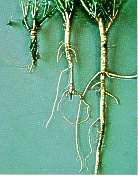
Description and Symptoms
The soil borne Phytophthora fungus infects the alfalfa root system. The infection can devastate large areas of the field. Leaves, especially lower ones, turn yellow or tan and may drop off. The plant grows slowly and whole plants may wilt or die. The key symptom to diagnose this disease though is lesions in the tap root. Split the tap root open to check for this disease. Discoloration if the root tissue starts about 6 - 8 inches below the soil. Red orange streaks spread up from the rotten root tip and in latter stages to yellow tan and then brown and finally black as the entire root dies. If the disease spreads to the crown the plant may die. Phytophthora root rot infected plants are very susceptible to winter injury. Infections are favored by warm weather (70 - 90 degrees F) and waterlogged conditions, especially in poorly drained fields.
Integrated Management
Plant resistant cultivars, many are available. Proper water management to avoid waterlogging is important. Adequate soil drainage is very important to manage this disease. Till the soil deeply to break up compacted layers that lead to poor drainage. Avoid long periods of standing water in the field. Provide adequate irrigation outlet and put in drainage if possible such as tiles, and drainage ditches. Even if infections have occurred, if further waterlogging is avoided the crop frequently recovers and new roots may grow on uninfected roots.
Impact
Common leaf spot cause by the fungus Pseudopeziza medicaginis is a very prevalent disease in alfalfa. The disease is limited to the leaves, but it can frequently reduce both yield and quality of alfalfa in early cuttings.
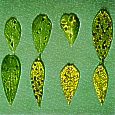
Description and Symptoms
Leaves have small, circular, brown to black spots or lesions. As the spots become older, a small raised disc, usually lighter in color, appears in the center of the spot. These are fruiting bodies or apothecia. Infected leaves turn yellow and drop off as the disease progresses. It does not kill plants directly bur reduces plant vigor, yield and harvest quality. This disease is favored by cool moist conditions. The fungus overwinters in plant debris. The disease starts in lower leaves and moves up the plant. Each spot is a separate infection. The disease diminishes with warmer temperatures and less free moisture.
Integrated Management
Plant resistant cultivars. If it is in a field, early harvest can save leaves before they fall. Extend irrigation intervals to dry up field between irrigations if possible.
Impact
Bacterial wilt can be a very serious disease of alfalfa. Resistant cultivars can mange this disease well.

Description and Symptoms
This disease is caused by the bacteria Corynebacterium insidiosum. First symptoms is a yellowish brown discoloration in the woody part of tap root. Plants become stunted with many yellow shoots having small, cupped leaves. The bacteria survive in the soil and plant debris and enter the plants though wounds. Older plants are more easily infected and once infection occurs stunting and death occurs in 5 - 8 months.
Integrated Management
Resistant cultivars are the best control of this disease.
Impact
This is also a serious alfalfa disease that can be controlled with resistant cultivars.
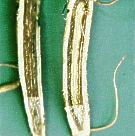
Description and Symptoms
This disease is caused by the fungus Fusarium oxysporum f. sp. Medicaginis. It is characterized by stems on one side of the plant wilting and dying. Brown to red streaks can be found in the roots and appear as partial or complete rings in the woody section of tap root. As the disease progresses, the entire root is discolored and the plant dies. Other fusarium species cause root, crown and seedling rots.
Integrated Management
Plant resistant cultivars. For damping off problems, avoid excess water and adjust seeding rates to absorb some seedling losses and favor rapid seedling growth.
Impact
Crown rot can be caused by various fungi that infect the alfalfa crown. These diseases cause biological pruning of branches and reduce plant vigor.
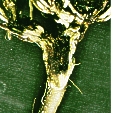
Description and Symptoms
Crown rots can be caused by one or more of the following fungi: Fusarium, Rhizoctonia, Phoma, Stagnospora, or Colletetrichum. The infection usually starts in the stems and branches of the crown as a discoloration. It spreads to the crown as a small cone shaped discoloration below the base of the cut. As the infection spreads, crown buds are often rotted and may progress until the entire crown is dead. Free moisture is usually needed for infection.
Integrated Management
Resistant cultivars can manage some types of crown rots, but others have no control like stagonospora.
Impact
This disease occurs is many areas under cool wet conditions. It often goes away by itself if conditions warm up and dry out. It normally causes little damage in the San Luis Valley of Colorado.
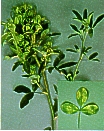
Description and Symptoms
Plants with Downey mildew have a distinctive pale green or yellow color. The cottony gray to purple growth on the underside of the leaves make it easy to distinguish form other foliar diseases. The edges of infected leaves may curl under or become twisted and distorted. Seedling plants are very susceptible and severe infections can kill seedlings. Mature stands usually only have problems with Downey mildew in the first cutting. Young leaves are much more susceptible that older leaves. Under conditions of low humidity and temperatures above 65 degrees F little growth of Downey mildew occurs.
Integrated Management
Plant resistant cultivars. Avoid frequent irrigations.
Impact
This is a warm weather disease that thrives under high humidity. The infection can occur on stems and crowns. Crown infections can lead to serious losses.
Description and Symptoms
This disease is caused by the fungus Colletotrichum trifolii. This disease is characterized by bleached, bent, dead young shoots and stems throughout the field. Stem infections are characterized by diamond shaped tan lesions with dark borders appear near the base of the stems. Tiny fruiting bodies can be seen in the center of the lesions. These infections may girdle and kill stems. A Shepard's crook shape is often observed in dead shoots. Crown infections are characterized by dry rot with a bluish black (gunmetal) color. Stems break off with infected crowns. The disease survives in dead debris and is spread by water and harvest machinery. The disease thrives in warm weather.
Integrated Management
Plant resistant cultivars. If a serious problem occurs, rotation with another crop for 2 - 3 years is necessary. Avoid excessive irrigation amounts and frequencies.
Impact
This can be a serious disease in hot areas with high soil moisture. It is rarely a problem in the San Luis valley of Colorado.
Description and Symptoms
This disease is caused by the fungus Rhizoctonia solani which is common in the soil. It infects both the root and stem. Stem infections have dark sunken cankers near the base. The cankers may girdle and kill the stems. On the roots the fungus causes elliptical tan to buff sunken cankers. The root cankers are often darker at the margins and turn black with age. The disease can also cause seedling and crown rot as mentioned above. The infection is very spotty in a field, distinguishing it from scald which kills many plants in an area. The fungus thrives in hot weather and will become inactive in cool conditions.
Integrated Management
Plant resistant cultivar, though many are not available. No other management methods are available.
Impact
This disease is favored by cool moist weather and usually is only a problem in the first cutting. It usually only affects hay quality.
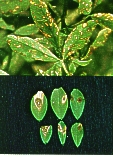
Description and Symptoms
This disease is caused by the fungus Stemphylium botryosum. Spots on the leaves are slightly sunken and dark brown with a lighter center. Young lesions are surrounded with a yellow halo. Older spots may have concentric rings resembling a target. Once lesions are formed they do not increase in size. The disease survives in plant debris. Drier conditions and hotter temperature (above 70 degrees F) can inhibit the disease.
Integrated Management
No control options exist. Some mild resistant varieties exist.
Impact
This disease occurs in early spring under cool wet weather. It rarely is a problem.
Description and Symptoms
The disease is caused by the fungus Sclerotinia sclerotiorum. The first symptoms occur in the fall as small brown spots on leaves and stems. In early spring the crown and lower parts of stem become soft and discolored. As the infected parts die a white fluffy mass grows over the area forming hard, black bodies (sclerotia) which may adhere to the surface or be imbedded in the stem or crown.
Integrated Management
No control options are usually necessary. Avoid overly frequent irrigations.
Impact
This disease has not been proven to be economically important in alfalfa. The infected plants can infect other plants such as potatoes, tomatoes where the disease is more important. In the San Luis valley of Colorado this secondary infection of the potato crop is the major negative impact of this disease.
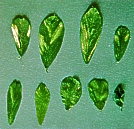
Description and Symptoms
Symptoms of alfalfa mosaic are yellow steaks between the leaf veins or light green to yellow mottling of the leaflets. Malformation of the leaflets can occur. Plants are sometimes stunted. Many infected plants show now symptoms at all. Symptoms are more apparent in the spring and fall. Aphids spread the virus from plant to plant and other crops. Seeds can also become contaminated.
Integrated Management
No control measures are necessary.
Impact
These two weevils are the major pests of alfalfa. They are indistinguishable form each other and have similar habits. They mainly differ in distribution. Larva of both weevils cause significant damage on the first cutting of alfalfa and at times delay the second regrowth.

Description and Symptoms
Adults are light brown with dark brown and grey markings down their backs and have the elongated snout. They are about 1/8 inch long which is bigger than the clover root curculio. The larva hatch and move up to the stem tips where they feed and are virtually hidden by the tightly folded leaves. Older larva are darker green with a white stripe down their back. After the larva finish feeding they drop to the ground and pupate. The rate of development depends on temperature so each year the timing and severity of problems can vary. Stages of growth can be determined by degree days.
Degree day Requirements of various stages of Alfalfa Weevils
| Growth Stage | Degree - days |
| Egg | 117 |
| 1st Instar Larva | 46 |
| 2nd Instar Larva | 46 |
| 3rd Instar Larva | 55 |
| 4th Instar Larva | 58 |
First and second instar larva only feed on young developing leaves. 3rd and 4th instar larva do the most damage, often skeletonizing leaves and defoliating plants. Adult feeding is not a problem. Weevil damage is sometimes severe under windrows. Weevil damage can also prevent regrowth of the 2nd cutting.
Integrated Management
Parasitic wasps are a good natural predator, but populations often overwhelm natural predators. Check fields with a sweep net during the middle to the end of the first cutting. There are two thresholds for control measures: capture of 15 - 20 larva per sweep or if 20 - 30% of terminal buds are affected. Cutting early before populations can be an effective control, but monitoring damage in the windrow and subsequent 2nd cutting regrowth is important. A level of 8 weevils per sq. ft. is the threshold for control of 2nd cutting regrowth. Insecticides are used to control high levels of weevils. Take care to observe the pre-harvest intervals and move any bee colonies or spray when honey bees aren't active.
Impact
These are the three main aphids that can cause problems in alfalfa. Other aphids can be found in alfalfa fields, but often they are just passing through. They cause occasional problems in alfalfa fields.
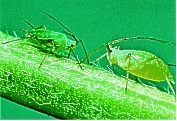

Description and Symptoms
The pea aphid (Acyrthosiphon pisum) and blue alfalfa aphid (Acyrthosiphon kondoi) are very similar in appearance. The best way to tell them apart is their antennae. The pea aphid antenna is green with a narrow dark band at the outer end of each segment. The blue alfalfa antenna is uniformly dark. The spotted alfalfa aphid (Therioaphis maculata) is easy to distinguish form these other aphids. It is pale yellow with 4 to 6 rows of dark spots, each with a spine, running lengthwise down its back. All these aphis do best at mild temperature, but the pea aphid and spotted alfalfa aphid can tolerate more heat. They all produce multiple generations each season which are regulated by temperature. They have both winged adult forms and nymph forms and reproduce both sexually and asexually. All these aphids stunt growth and can reduce yield if their populations are high. The spotted alfalfa aphid injects a toxin which further stunts the plant. Honeydew can accumulate with high aphid populations which can lower hay palatability and increase susceptibility of the alfalfa to diseases.
Integrated Management
Monitor aphid populations with a sweep net. Aphid levels can also be monitored as level of aphids per stem. Thresholds for control levels are in the following table.
| Plant Height | Pea Aphid | Blue Alfalfa Aphid | Spotted Alfalfa Aphid |
| Under 10 inches | 100/sweep | 100 - 200/sweep | 20/sweep |
| 10 - 20 inches | 100 - 200/sweep | 100 - 200/sweep | 50/sweep |
| Over 20 inches | 200 - 300/sweep | 100 - 200/sweep | 50/sweep |
There are many natural predators of aphids in alfalfa fields. Some of the important ones are ladybugs, damsel bugs, collops, big eyed bugs, and lacewings. Conserve these natural predators by avoiding unnecessary pesticides, leaving some reserve during cuttings. Certain insecticides can actually increase aphid populations by killing off natural predators while leaving aphids. Monitor lady bug levels and don't spray if levels of predators is high. Use the ratios below to determine if there are enough ladybugs to control aphid levels.
If the ratio of ladybugs to aphids is equal or exceeds the ratios below, control measures are not necessary
| Lady bug levels per sweep | Aphid levels per sweep |
| Adult Ladybugs: 1 To | 5- 10 |
| Ladybug Larva: 3 To | 40 |
Impact
Blister beetles are occasional pests of alfalfa. Their direct feeding is not usually a problem, but if there are too many of them baled in hay, they can lower the palatability of the hay and even be poisonous to horses or cattle fed the hay.
Description and Symptoms
There are three types of blister beetles that infest alfalfa. The three-striped blister beetle, the spotted blister beetle, and the black blister beetle. The three stripped is brown and yellow stripped. The spotted blister beetle is grey with black spots. The black blister beetle is larger than the others and all black and sometimes have a greenish iridescent shine. If you touch any of these beetles they will burn you. They are attracted to the alfalfa flowers.
Integrated Management
Monitor levels with a sweep net. The beetles differ in their toxicity to livestock. Cattle are more tolerant to blister beetles. Below is a table of relative toxicity to horses.
| Three - Striped Blister Beetle | 5 ingested can kill a 1,200 lb. horse |
| Spotted Blister Beetle | Moderately toxic |
| Black Blister Beetle | Least toxic and most common |
Control blister beetles by cutting alfalfa before is blooms extensively to not attract beetles. Don't crimp alfalfa while swathing so beetles aren't killed and fly off before baling. Pesticides are rarely needed.
Impact
This is a sporadic pests and usually natural predators keep the problem in check. Control is rarely needed.

Description and Symptoms
The adults of the alfalfa caterpillars (Colias eurytheme) are a common sight in fields. The adults have yellow to white wings which are bordered with black on the upper side. The wingspan is a little less than 2 inches. The larva are plain green and quite hairy reaching a length of about 1 ½ inches when fully grown. Larger caterpillars have a white strip on each side. The larva's velvety green surface is a distinguishing feature from other caterpillars. A single generation takes about the same time as a hay cutting cycle. The caterpillars eat entire leaves as distinguished from armyworms that leave the midrib intact.
Integrated Management
Encouraging and preserving natural predators is the best control. Parasitic wasps are important predators as well as damsel bugs, big eyed bugs and spiders. Avoid unnecessary insecticides. Use selective insecticides if necessary.. Leave a reserve of alfalfa during cutting for predators. Monitor levels with a sweep net. Threshold of 10 large alfalfa caterpillars per sweep may indicate control measures are necessary. Bt's work well as well as pyrethroids.
Impact
Cutworm occasionally cause serious damage in seedling alfalfa and alfalfa regrowing in the spring. Cutworm population often develop in weedy areas near fields and latter move into the alfalfa.
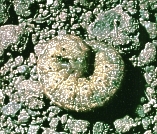
Description and Symptoms
Cutworms (Peridroma saucia and other species) are yellow to brown with a row of yellow diamond spots on their back. They grown to a length of 1 ½ to 2 inches long. When disturbed they curl up and form a "C". There can be 3 - 4 generation each season. Cutworms are mainly nocturnal. They damage the alfalfa by cutting off the seedlings or new stems at the ground level.
Integrated Management
Monitor cutworm levels by digging around young plants and crowns in the spring. Levels of 1 cutworm per square foot justify control measures. An alfalfa field that is slow to regrow in the spring may have cutworm problems. The presence of lots of blackbirds in a alfalfa field may also signal the presence of cutworms. Control is best accomplished by chemigating pyrethroids.
Impact
These two armyworms have different appearance, but similar life cycles, damage symptoms and management. They are normally not an annual problem, only occasionally causing significant damage.

Description and Symptoms
The beet army worm (Spodoptera exigua) eggs are laid in cottony clusters. The larva can range in color from bright green to almost black. There is a dark stripe running down the center of the back and a yellow stripe on each side. The Western Yellow striped armyworm (Spodoptera praefica) lays its eggs in clusters covered with grey scales. The larva are usually black with two prominent orange yellow stripes and many narrow stripes down each side. It gets slightly larger than the beet armyworm at maturity. Army worms skeletonize the leaves, leaving veins intact. The feeding can cause flagging of skeletonized leaves.
Integrated Management
Natural predators are the best control so it is important to preserve and encourage natural predator populations. Parasitic wasps are important predators as well as damsel bugs, big eyed bugs and spiders. Avoid unnecessary insecticides. Use selective insecticides if necessary.. Leave a reserve of alfalfa during cutting for predators. Monitor levels with a sweep net. A threshold of 15 large larva per sweep justifies control measures. Early harvesting is an effective control if high populations occur late in the growth cycle. Bt's and pyrethroids work well for control.
Alfalfa fields normally contain high populations of insects, both predators, pests and non-damaging insects. For someone accustomed to the insect clean fields of some vegetable, alfalfa fields can seem crawling with bugs. This is normal and in many cases is not damaging the quality and yield of the alfalfa. Below is some of the minor insect pests that can be found in an alfalfa field, which although they feed on the alfalfa, rarely cause any problems.
Clover Root Curculio
The adult is a small brown beetle with a short snout that feeds on leaves.. The larva are grub-like and feed on roots. .
Webworms
Webworms feed inside leaves it has webbed together. They are dark green with white stripes and black spots.
Sowbugs
Sowbugs occasionally feed on re-seeded fields and are not really insects, but crustaceans. They are gray and oval in shape and curl up into a ball when disturbed.
Leafhoppers
Leafhoppers can be quite abundant in alfalfa fields in the summer. They are small triangle shaped insects that can hop large distances. Leafhopper feeding can cause stunted growth and yellowing of leaves if populations are high enough, but they rarely do economic damage to an alfalfa field. Another form of damage is after cutting alfalfa fields, large populations of leaf hoppers can move out into other more sensitive crops like lettuce and potatoes. Monitor sensitive crops for leafhoppers after a nearby alfalfa field is cut.
Lygus bugs
Lygus bug populations can be quite high at times with little known damage. They are small beetles that ranges in color from green to brown and have a distinctive yellow to beige triangle on their back.
Thrips
These are very small long insects that feed on young leaves. You need a hand lense to see them.
Note: This information should only be used as a guide. Adjustments for local conditions must always be made.